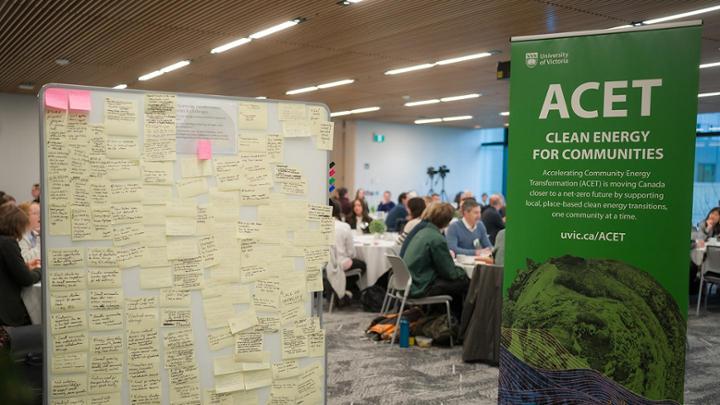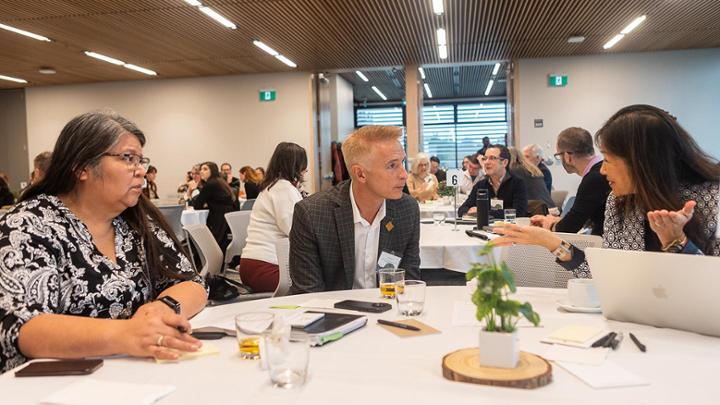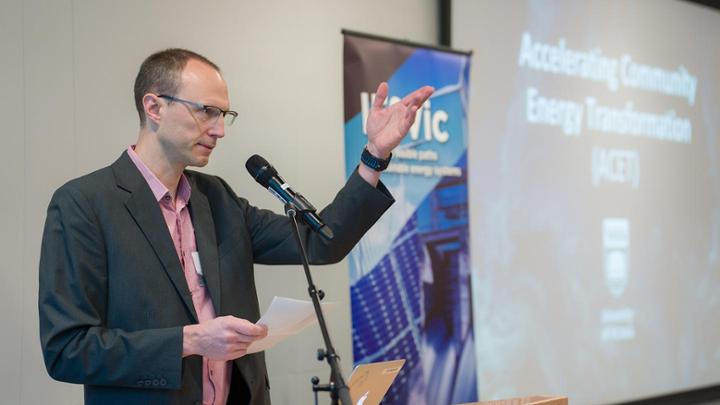Good hearts, clean energy: a transformation begins
January 09, 2024

Elders Kathy Horne and Doug Lafortune, both members of local First Nations, welcomed almost 100 partners, collaborators and team members to UVic with an invitation to bring their good hearts to the important work of Accelerating Community Energy Transformation (ACET).
“It’s always nice to come and be witness to see the good works that are happening throughout all of our territories,” Horne said. “I know a lot of you travelled here from different parts of our territories and we really are appreciative of all the good work that you do. Our Mother Earth, you know, is in very dire need of care, loving and attention, and [I’m glad] to hear the good work that all of you are pursuing and working towards a better way of living, sustaining ourselves in a good way.”
On November 30, 2023, the gathering officially launched ACET, a seven-year $84M community-engaged research initiative, bringing people together to jointly identify impactful research ideas spanning all aspects of transitioning communities to clean energy, from scalable technologies and public policy solutions to economic impact and real-world implementation.
There was certainly a lot of good energy in the room as representatives of communities, governments and NGOs described their steps or strides so far—and those they aspire to. Table discussions provided venues for small groups to share ideas and experiences, opportunities and challenges for community energy transformation, intersectional opportunities, technology and much more.

To introduce the breakout conversation on technical solutions and feasibility, Andrew Rowe, director of UVic’s Institute for Integrated Energy Systems, said, “What was, what is, what shall be, I think is why we’re in the room, right? To try to look at the past and where are we today and how do we get to the future…. How do we pick and choose from all the choices we have, and some that are yet to come, to make this transition happen?”
Tristan Gale, Malahat Nation’s executive director of environment and sustainable development, said, “That whole-of-industry approach, that all-hands-on-deck approach that ACET brings to the table is critical to achieving success at the scale that Malahat Nation intends.”
“That’s really the ethos here,” ACET Executive Director Curran Crawford said. “To bring together all the bright minds, the research and this bottom-up research definition from communities.”

Almost 80 per cent of Canadians live outside of major metropolitan areas. The resources and capacities of smaller communities are different from big cities—and from each other. ACET works with a mix of Indigenous and non-Indigenous communities with fewer than 500,000 residents, including some that are quite small and/or remote.
The plan for the seven years of the project is that the partners, collaborators and team members will work together to help and support individual communities advance what they want to achieve energy-wise, and from there look at the larger lessons: what can be translated to other communities across Canada and, ultimately, around the world.
“With ACET,” says Crawford, “we’re trying to position ourselves to help people understand what their energy systems could be as they consider possible net zero futures.”
Rachel Goldsworthy
